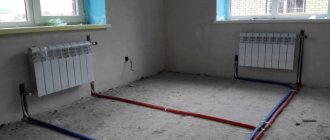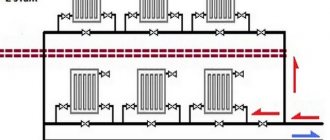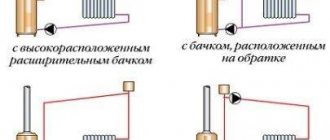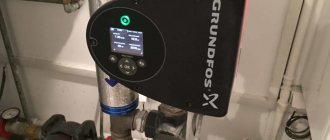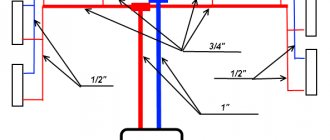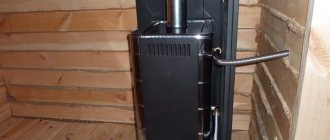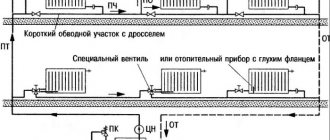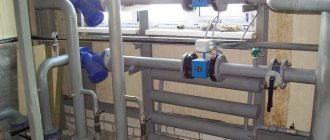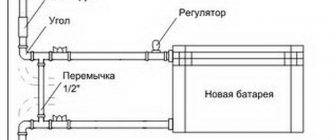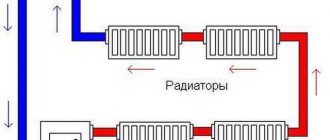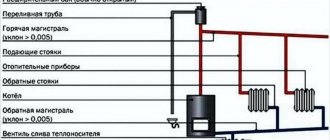If the area of the house is large enough or it is necessary to provide heating for a two-story building, it is better to abandon a heating system with natural circulation. Due to the slow movement of the coolant through the pipes, it will be extremely difficult to warm the air in the room quickly enough.
This problem does not exist if a heating system with forced circulation is initially selected, which is especially important for houses in which people live permanently. By installing a special pump, you can significantly increase the heating efficiency of a building of any size. The main thing is that the selected heating scheme meets certain requirements.
How does heating work without a pump?
To understand how a forced circulation system works, it is worth understanding how buildings are heated using natural coolant circulation. As the latter, various special compounds and water can be used. For a one-story house, water heating is most often chosen.
The movement of water through pipelines is carried out according to the laws of physics. Having heated up in the boiler to a given temperature, it begins to rise up the riser. Due to this, all pipes and radiators of the system are gradually heated. The newly incoming hot water gradually displaces the cold water down to the boiler.
After the cooled coolant heats up again in the boiler, it will begin to rise up the riser to displace the cooled down. This cycle will be repeated as long as the boiler operates. Obviously, the larger the diameter of the pipe, the more coolant will pass through its cross section per unit time.
That is why, with natural circulation, the diameter of the pipeline and the dimensions of the mounted radiators are of great importance. If the area of the latter is insufficient, it will be difficult to warm the room to a comfortable level.
Schemes of heating systems with forced circulation
Single-pipe heating system
In private homes, a single-pipe system is often produced, where there is no division into forward and return pipes. All radiators are connected in series; as the coolant passes through them, it will gradually cool down and return back to the boiler.
Largely due to this, the system turns out to be quite simple and economical, but some effort will have to be made in order to correctly calculate the temperature regime and place the required number of radiators.
A single-pipe scheme can only be used if the house is not too large and has only one floor. The pipe must go directly through all radiators; control valves are not installed here, as they will impede the passage of coolant to radiators installed further in the system, and subsequently to the boiler.
If we take into account the positive aspects of such a system, then there is only one such point - this is the short length of the pipeline, the purchase of which can save a lot of money. There are many more disadvantages:
- The coolant is distributed unevenly throughout the system. In particular, if the radiator is located quite far from the boiler, then it will warm up very slowly;
- To carry out repair work related to the heating system in the house, you will have to turn off the boiler and wait until the coolant has completely cooled down.
A circulation pump designed for a single-pipe heating system should not have excessive power, since there is not too much coolant.
In a two-pipe scheme, the consumption of materials, in particular pipes, will be significantly greater - approximately twice. However, the operating efficiency of a two-pipe heating system is much higher, because there is another line through which the cooled coolant will return back to the heating boiler.
Ensuring proper forced circulation here is a little more difficult, but with the right approach to this issue, heating will work much more efficiently, and you will also have to pay less money for fuel for the boiler.
At the first stage, a corresponding project is drawn up, which will need to be adhered to during installation. The forward and return lines are located in close proximity to each other so that there is no more than 15 cm between them. There are quite a lot of distinctive features of such a system:
- The diameter of the laid pipes usually ranges from 15 to 24 mm. Even such small indicators will be quite enough to create the required amount of pressure;
- Pipes can be routed both horizontally and vertically;
- The more turns there are in the system, the worse the hydrodynamic performance of the heating system will be. In this regard, it is advisable to consider that there be significantly fewer of them;
- If the pipes are hidden, then you will definitely have to install so-called inspection or dormer windows.
When installing a circulation pump, a bypass channel should be placed, which will allow the coolant to move through the system even if the electricity is turned off. The pump power is selected depending on the area planned to be heated. It is advisable to know the maximum and operating parameters of the device, its performance and a number of other factors.
Forced circulation
The heating circuit with forced circulation is characterized by the presence of a pump. Thanks to it, the coolant moves through the pipes at a given speed, and not just under the influence of the laws of physics.
The pump creates pressure sufficient to move the coolant, but at the same time ensuring uniform distribution of water heated to different temperatures.
Principle of operation
During natural movement in the heating system, the heated liquid from the boiler under the influence of temperature itself creates pressure and rises up through the pipes, enters the radiators, and when cooled, returns to the heating device. Accordingly, radiators close to the boiler will be warmed up well, while those further away will be the opposite. In order to maintain a more or less stable temperature in different rooms, it is necessary to increase the number of sections on the heating radiators and increase the diameter of the pipes, as well as calculate the slope of the pipeline so that the coolant moves along the line according to the laws of physics.
A forced circulation pump promotes rapid fluid movement without increasing pressure or losing temperature. There are several more advantages:
- There is no need to use pipes with a large diameter for installation;
- There is no temperature difference - no rapid wear of system elements;
- Ability to regulate temperature in individual rooms;
- There is no need to calculate the slope for unimpeded movement of the coolant.
The disadvantage of the pump is its noise during operation. You need to choose good low-noise models.
What does the heating system consist of?
The forced circulation heating system consists of:
- boiler (solid fuel, gas or electric);
- membrane type expansion tank;
- circulation pump, the power of which is selected individually;
- heating radiators (batteries);
- pipes;
- fittings - adapters used to connect pipes;
- valves (ball and plug);
- check valves;
- air vents;
- filters that ensure the operation of the heating boiler and pump;
- fasteners.
When choosing the equipment necessary for the operation of the system, be sure to take into account:
- power of the purchased boiler and radiators;
- pipeline size;
- coolant movement speed.
How to choose a heating pump
Special low-noise centrifugal-type circulation pumps with straight blades are best suited for installation. They do not create excessively high pressure, but push the coolant, accelerating its movement (working pressure of an individual heating system with forced circulation is 1-1.5 atm, maximum - 2 atm). Some pump models have a built-in electric drive. Such devices can be installed directly into the pipe; they are also called “wet”, and there are devices of the “dry” type. They differ only in the installation rules.
When installing any type of circulation pump, it is desirable to install it with a bypass and two ball valves, which allow you to remove the pump for repair/replacement without stopping the system.
It is better to connect the pump with a bypass - to be able to repair/replace it without destroying the system
Installing a circulation pump allows you to regulate the speed of movement of the coolant through the pipes. The more actively the coolant moves, the more heat it carries, which means the room heats up faster. After the set temperature is reached (either the degree of heating of the coolant or air in the room is monitored depending on the capabilities of the boiler and/or settings), the task changes - it is necessary to maintain the set temperature and the flow rate decreases.
For a heating system with forced circulation, it is not enough to decide on the type of pump. It is important to calculate its performance. To do this, first of all, you need to know the heat loss of the rooms/buildings that will be heated. They are determined based on losses in the coldest week. In Russia they are standardized and installed by public utilities. They recommend using the following values:
- for one- and two-story houses, losses at the lowest seasonal temperature -25°C are 173 W/m2, at -30°C losses are 177 W/m2;
- multi-storey buildings lose from 97W/m2 to 101W/m2.
Based on certain heat losses (denoted by Q), you can find the pump power using the formula:
Q/c*Dt,
c – specific heat capacity of the coolant (1.16 for water or another value from the accompanying documents for antifreeze);
Dt – temperature difference between supply and return. This parameter depends on the type of system and is: 20°C for conventional systems, 10°C for low-temperature systems and 5°C for heated floor systems.
The resulting value must be converted into productivity, for which it must be divided by the density of the coolant at operating temperature.
In principle, when choosing pump power for forced circulation of heating, you can be guided by average standards:
- with systems heating an area of up to 250 m2, units with a capacity of 3.5 m3/h and a generated pressure of 0.4 atm are used;
- for an area from 250 m2 to 350 m2, a power of 4-4.5 m3/h and a pressure of 0.6 atm is required;
- in heating systems of areas from 350 m2 to 800 m2, pumps with a capacity of 11 m3/h and a pressure of 0.8 atm are installed.
But you need to take into account that the worse the house is insulated, the greater the power of the equipment (boiler and pump) may be required, and vice versa - in a well-insulated house, half of the indicated values may be required. These data are average. The same can be said regarding the pressure created by the pump: the narrower the pipes and the rougher their internal surface (the higher the hydraulic resistance of the system), the higher the pressure should be. A full calculation is a complex and tedious process, which takes into account many parameters:
Boiler power depends on the area of the heated room and heat loss
- resistance of pipes and fittings (read about how to choose the diameter of heating pipes here);
- pipeline length and coolant density;
- number, area and type of windows and doors;
- the material from which the walls are made, their insulation;
- thickness of walls and insulation;
- presence/absence of a basement, basement, attic, as well as the degree of their insulation;
- type of roof, composition of the roofing pie, etc.
In general, thermal engineering calculations are one of the most complex in the field. So if you want to know exactly how much power you need for the pump in the system, order a calculation from a specialist. If not, select based on average data, adjusting them in one direction or another depending on your situation. You just need to take into account that if the coolant flow rate is not high enough, the system makes a lot of noise. Therefore, in this case, it is better to take a more powerful device - the energy consumption is low, and the system will be more efficient.
Single-pipe scheme
The single-pipe scheme involves combining the supply and return pipelines. The coolant is supplied through a special pipeline with shut-off valves. A separate pipe with a valve is provided for draining water into the sewer.
After heating in the boiler, the coolant, passing through the risers and radiators and giving them the required amount of heat, enters the pump. The latter ensures injection of the flow moving to the boiler.
Tank
A membrane-type tank, which includes a single-pipe system, helps prevent emergency situations.
Such a tank can be not only closed, but also open. It is installed on the top (technical) floor of the building.
If the tank is closed, then the heating system is closed. If it is open, then the system is called open.
Security group
A one-pipe system necessarily includes a safety group consisting of:
- air vent;
- safety valve;
- pressure gauge and thermometer, often combined in one housing.
Such a group will allow you to quickly reduce excess pressure in the system, thereby preventing pipeline rupture and equipment breakdown.
It is permissible to install devices from the safety group separately from each other. For example, the safety valve is inserted slightly above the boiler. However, this is not always justified in terms of the cost of installing a heating system.
Radiators
Radiators with this scheme can be connected in different ways: diagonally, parallel, etc. It is advisable to provide thermostats and Mayevsky taps on each battery. On sale you can find radiator models with pre-installed taps.
Wiring
The pipe layout in the system can be horizontal or vertical. Both types of wiring allow connection to a boiler and underfloor heating system.
To do this, you just need to provide a special distribution manifold to ensure that the heated coolant flows simultaneously into the radiators, boiler and underfloor heating circuit.
Water circulation in boilers
Water circulation is the movement of water in a closed loop. The circulation circuit, in general, includes such structural elements of boilers as drums, collectors, heated and unheated pipes of heating surfaces. Water can pass through the circuit repeatedly or once, moving through the heating surfaces from inlet to outlet.
Depending on the reasons that cause the movement of water, circulation is divided into natural and forced.
Natural circulation occurs in steam boilers, since the driving pressure in the circuit is created by the difference in the densities of water and steam. In this case, each kg of water can gradually turn into steam, repeatedly passing through the circuit, or turn into steam in one pass through the heating surface.
Forced circulation of water is carried out using a pump. It is used in hot water boilers and water economizers and is direct-flow.
With any type of circulation and methods of its organization, the water and steam generated in the circuit must reliably cool the metal, which is necessary for trouble-free operation of the boilers.
Natural circulation of water in steam boilers. Let us consider the principle of operation of natural circulation using the example of the circulation circuit of the side screen of the furnace (Fig. 10).
Rice. 10. Scheme of the simplest natural circulation circuit:
1 – collector; 2 – downpipe; 3 – upper drum; 4 – screen (lifting) pipes.
Feed water is introduced into the upper drum of the boiler 3. From it, the water descends through the downpipe 2 and enters the collector 1. In this section of the circuit, heat is not supplied to the water (the pipe is thermally insulated with a fireclay wall) and the water temperature remains below the saturation temperature at a given steam pressure in boiler
From the collector, water enters the heated pipes of the screen 4 and, rising through them, is heated to a boil, boils and partially turns into steam. The resulting steam-water mixture is introduced into the drum, where it is separated into water and steam. The steam leaves the boiler, and the water mixes with the feed water and reenters the circulation circuit.
The section of rising pipes where water is heated to boiling is called economizer, and the section containing steam is called steam-containing. The height of the latter is several times higher than the height of the economizer section.
In the economizer section, water moves at a constant speed, and in the steam-containing section it constantly increases, since the amount of steam generated in the riser pipes continuously increases. The speed that water has in the economizer section is called circulation speed. Due to its constancy, the circulation speed is one of the important characteristics of natural circulation. Its value is approximately 0.5 - 1.5 m/s.
The presence in the circuit of areas with media having different densities creates a pressure difference or driving circulation pressure in the circuit. The pressure in the lowering pipes is created by a column of water with a density rB, and in the rising pipes - by a column of water and a steam-water mixture with a density rSM . Therefore, a more dense medium displaces a less dense medium and a circular movement of water is created in the circuit. The magnitude of the driving pressure is determined by a relationship of the form:
SDV = hPAR (rB - rSM) g Pa, (7.1)
where hSTEAM is the height of the steam-containing section of the riser pipes; g – free fall acceleration.
From the expression of the driving pressure it follows that for circulation it is not enough to have media with different densities. It is also necessary that steam-containing pipes be positioned vertically.
During one pass through the circuit, only part of the water turns into steam. Therefore, to characterize the intensity of water evaporation, the concept of circulation rate is used:
k = M/D, (7.2)
where M is the water flow through the downpipe, kg/h; D – amount of steam generated in heated pipes, kg/h.
Thus, the circulation rate shows how many times one kg of water must pass through the circuit to turn into steam. For screens k = 50 – 70, for convective beams k = 100 – 200.
The reciprocal of the circulation ratio characterizes the degree of dryness of wet steam x = 1/k. From this we can conclude that a steam-water mixture is formed in the screens, containing no more than 0.02 or 2% steam. Therefore, even the most heat-stressed heating surfaces of boilers, which are screens, are reliably wetted and cooled with water.
In convective bundles, all pipes are heated by gases, the temperature of which continuously decreases as they pass through the bundle. Therefore, in boiling tubes, as the gases move, the steam content also decreases, and the density of the steam-water mixture increases. The presence of a bundle of steam-water mixture with different densities in the pipes creates a driving pressure that moves the water according to the following scheme: from the upper drum, water enters the rear pipes of the bundle and through them enters the lower drum of the boiler; From the drum, water enters the remaining pipes of the bundle and, together with steam, enters the upper drum.
Forced circulation. Forced circulation is used in hot water boilers, as well as in economizers of steam boilers. The movement of water through the pipes of the heating surfaces is carried out by a pump. Water enters the heating surface cold and leaves it hot, performing a direct-flow movement in the boiler. The water circulation rate is equal to one.
To create a direct flow of water, the heating surfaces of boilers are made in the form of separate panels, which are connected to each other in series or in parallel. The panel is made from one row of pipes, the ends of which are closed to the lower (distribution) and upper (collection) collectors. In this case, the pipes can have both a straight (mostly) and a coil configuration.
When pipes are connected in parallel to collectors, water passes through the pipes at unequal flow rates, which is due to differences in the hydraulic resistance of the pipes and uneven heating of the pipes by gases. Therefore, less water flows into individual pipes than is necessary for reliable cooling of the metal. It is even possible for water to boil in individual pipes, which further reduces the flow of water into such pipes.
The movement of water in pipes can be either upward or downward. However, in order to avoid boiling of water, its speed is taken to be at least 0.5–1 m/s. For the same reasons, the water pressure drop in boilers should not be more than 0.2 MPa.
Two-pipe scheme
The advantage of a single-pipe scheme is its availability. In this case, fewer pipes are required than with a two-pipe system, and therefore its installation is much cheaper.
However, the efficiency of the latter is much higher, due to the fact that in a two-pipe system the supply and return pipelines are separated.
This system allows you to repair a radiator in one room without turning off the heating in the entire building, and is suitable for buildings of any number of floors.
Pipe slope in a scheme with natural coolant circulation
The movement of the coolant in complexes with natural circulation of the coolant is ensured by the difference in the densities of cold and hot water. Maintaining the slope here is a concomitant factor that improves the mode of movement of the coolant - under the influence of gravity, water moves through the pipes somewhat faster. Horizontal arrangement or reverse slope in open circuits is not allowed - a complete stop of circulation is possible.
The standard value of pipe slope in a gravity circulation scheme varies from 5 to 10 mm per 1 meter of linear length of the pipeline. During installation, the pipes are laid with a slope towards the movement of the coolant - the direct pipeline is inclined towards the heating devices, the return line is constructed with a slope from the heating devices towards the boiler located at the lowest point of the system. The second task of the slope in an open-type system is to ensure the drainage of equipment through the lowest point located near the boiler.
Is forced better?
If a heating system for a one-story building is to be installed, preference may be given to a system with natural circulation. Especially if the building is located in an area with typical power supply problems.
When choosing a scheme for a two-story house, it is better to pay attention to a system with forced circulation. Especially if the building area is large.
Save on pipes
If you prefer a forced circulation scheme, you don’t have to worry about the diameter of the pipe being installed. Due to the same coolant speed, it will certainly be possible to ensure uniform heating of the entire system.
That is why cheaper pipes are purchased for such a system. Considering that their diameter is somewhat smaller, the pipes can be made almost invisible in the interior.
Avoiding bulky radiators
With natural coolant circulation, bulky radiators are traditionally installed, taking up a lot of space. Due to their large area, such batteries allow for more efficient heating of rooms. In a heating system with forced circulation, preference may be given to even a small radiator model.
Safety and ease of use
Uniform heating of the heating system helps reduce the risk of damage to its elements due to significant temperature fluctuations. As a result, the negative impact on the material of all elements of the heating system is reduced and their service life increases.
Thanks to the presence of Mayevsky taps and special automatic air vents in the forced coolant supply system, there is no fear of airing. The degree of water heating can be adjusted not only by the parameters of the heating boiler, but also by the characteristics of the pump.
With natural circulation, radiators become colder the further they are from the boiler. This contributes to uneven heating of the rooms.
Easy to install
The pipes do not have to be laid at a certain angle, which makes it possible to carry out the work on your own. If this rule is violated, in the case of natural circulation it will not be possible to ensure the passage of coolant through the system, and therefore heating a two-story house will be difficult or impossible.
System implementation options
Systems with forced coolant circulation can have very different configurations.
The location of pipes and heating radiators, as well as their connection diagram, directly depend on the scale of the system. As a rule, in private houses they implement either a one-pipe or two-pipe system with artificial coolant movement:
- A single-pipe system is most often installed either in industrial buildings or in houses with a small area. In such a system, the coolant from the heating boiler enters the main pipe (riser), and then moves sequentially through all radiators. Depending on the configuration, single-pipe systems can be vertical or horizontal. The main disadvantage of this solution is the uneven distribution of heat: radiators located closer to the boiler heat up more intensely than those located further away.
- Installation of two-pipe systems is more expensive, because two separate pipes must be connected to each heating radiator - forward and return. In addition, when installing a two-pipe system, it is advisable to use a manifold assembly that will ensure distribution of the coolant - for example, such as the distribution manifold for the Designstal KK-40F/125/40/2 boiler. On the other hand, with this configuration of the heating system, the problem of uneven heating of radiators is solved - after all, all devices are connected individually.
The choice of system type depends primarily on the characteristics of the room in which it will be installed. But in general, the two-pipe version is more effective, although its installation requires more time, effort and money.
About the disadvantages
Considering that the system contains a circulation pump, a mandatory connection to the electrical network is required. In areas with frequent power outages, this fact can create serious problems. If desired, you can get rid of this problem by providing an uninterruptible power supply.
Also, do not forget about the possible increase in the cost of paying electricity bills. To do this, it is worth making the appropriate calculations before purchasing equipment. Sometimes, due to the fact that pipes with a smaller diameter are installed, coolant consumption is reduced.
This, in turn, leads to a reduction in the power consumed by the boiler. As a result, the cost of operating the pump can be fully compensated by reducing the cost of operating the boiler. Operation of the pump is accompanied by slight noise. If the equipment is installed in a separate room, such a drawback does not deserve attention. However, for a small house or one-room apartment this can be a serious problem.
If a heating system with forced circulation is installed to heat a two-story building, there is no doubt: such a house will always be warm, quiet and comfortable.
Water heating
The water-type forced circulation system is closed. A pump operating under pressure pumps water through a pipeline. Then it goes back into the boiler and retains residual heat, so there is no need to heat the water very much. The room receives heat from radiators, which can be made of cast iron, steel, aluminum or bimetallic. (See also: Water pumps for heating)
Manifold for heating system
Many systems use free-standing heat exchangers. The principle of heating a room is as follows: cold air from the room enters from the bottom of the radiator and passes through its fins, heating up at the same time. It comes out already hot from the top.
If the heating system with forced circulation includes old cast iron radiators, then they need to be replaced with more modern sectional wall-mounted or free-standing analogues. New radiators have more advantages: they take up less space, look better and have high heat output. But before you choose any type of radiator, you need to make sure that your heating unit will provide a sufficient volume of water.
Some systems have a thermostat, which ignites the boiler burner and controls the pump motor. When the temperature drops lower than necessary, the burner turns on. And if the water overheats, it turns off. (See also: Solid fuel boilers)
How is a water heating system regulated?
The heating system can be adjusted using several parameters. But before you start using the system, you need to read the operating manuals. First of all, invite a technician to adjust the start-stop cycle (they should be short but frequent). In this case, it is easier for the heating system to maintain the desired temperature in the room even with a sharp change in temperature outside the building.
Thermostat design
Advice! If it is very cold outside, increase the pressure in the system (this will allow more heat to flow to the heating radiators).
Remember that a large number of different elbows and small angle turns of the pipeline will significantly reduce the efficiency of the system. It is better to replace such knees with those with larger rotation angles. So the hydraulic resistance will be less. To reduce heat loss even less, it is worth insulating the pipes themselves that do not pass through residential premises (for example, a basement). Hardware stores have been using this for a long time. (See also: Warm home)

